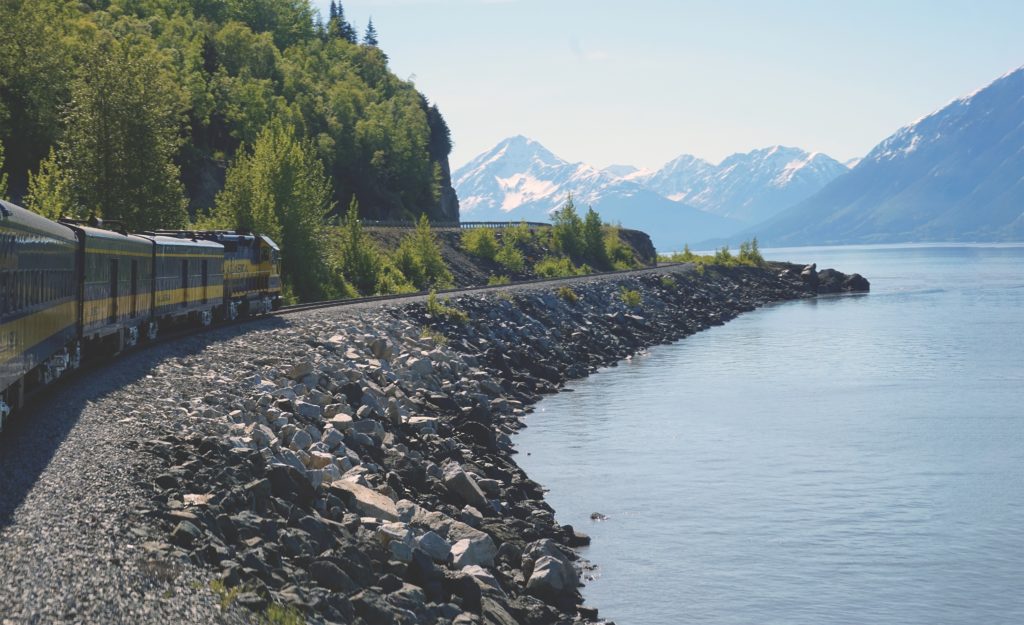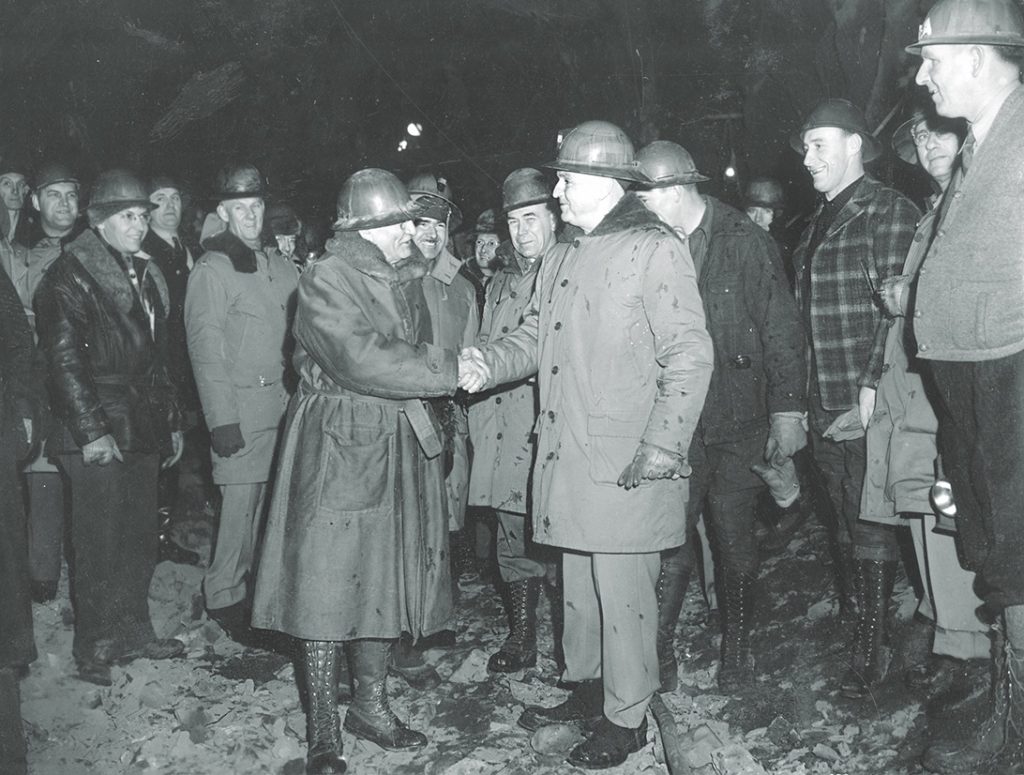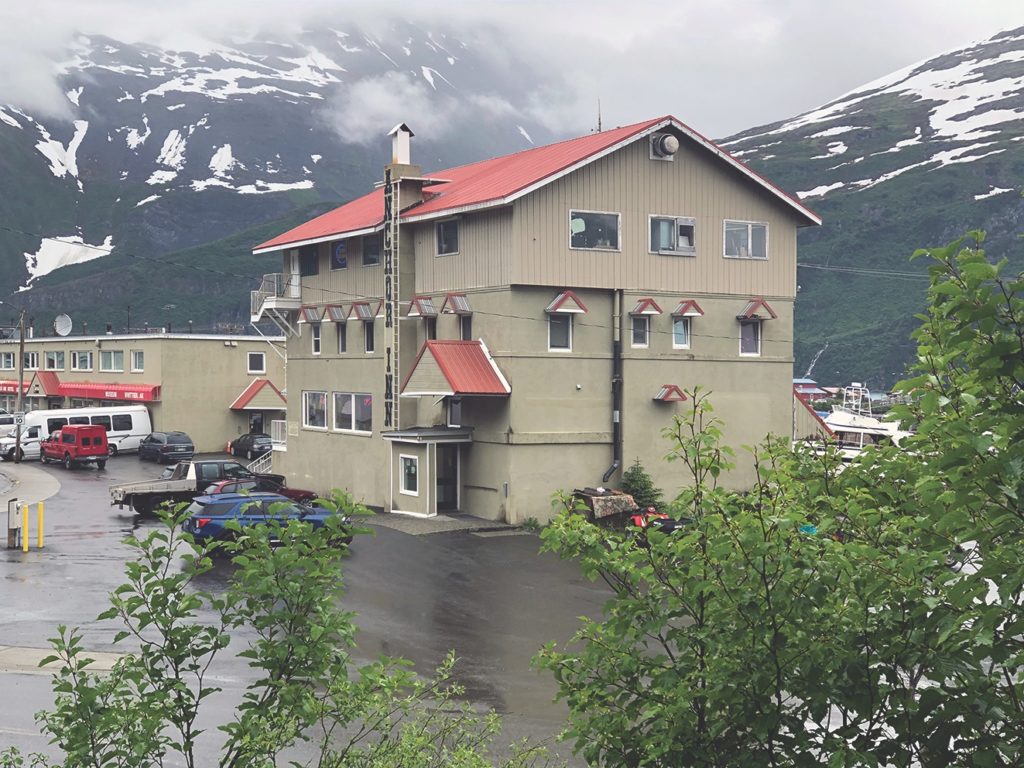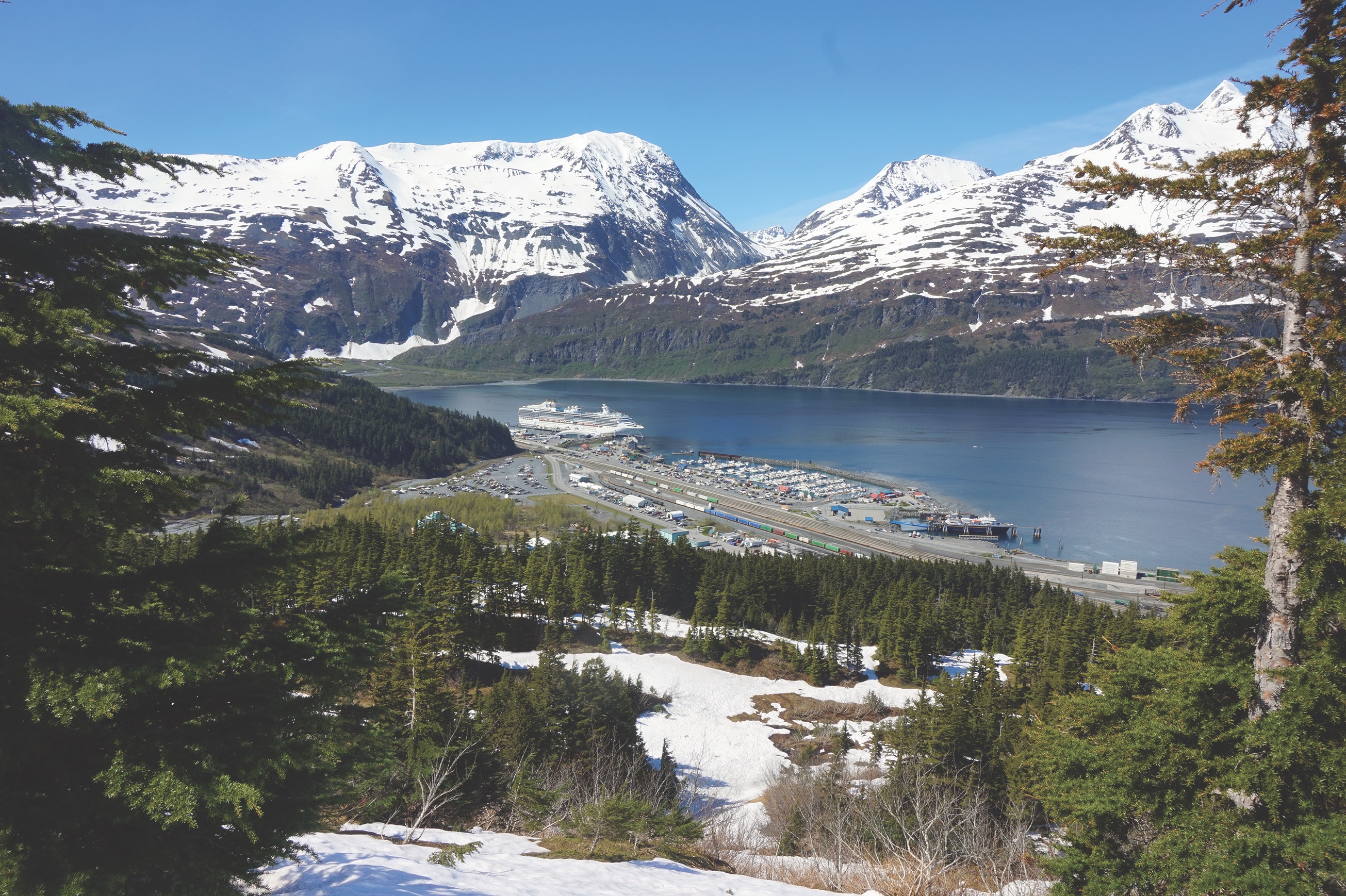Situated on Prince William Sound’s scenic Passage Canal, Whittier was designed and built as a U.S. Army base during World War II.
IT’S RAINING the day my train rattles through the Anton Anderson Memorial Tunnel and comes to a halt in front of a rail yard in Whittier, Alaska. I disembark beside a small harbor crowded with fishing vessels and pleasure yachts and absorb the view. In the foreground, I see railway tracks, port facilities, and a small cluster of shops and eating joints. In the background lurk two humongous buildings—one practically a ruin, the other looking like a displaced New York condominium—rising incongruously in front of a beautiful backdrop of glaciers and mountains.
I had boarded the Glacier Discovery in Anchorage in glorious sunshine. Now, two hours later, I’m standing dockside in Whittier under a gray cover of sloppy clouds and incessant drizzle. It’s hardly surprising. If it wasn’t for the foul weather, this peculiar little Alaskan port would never have existed in the first place.
Shortly before the Japanese attack on Pearl Harbor in December 1941, Simon Bolivar Buckner Jr., the American general in charge of Alaska’s nascent Defense Command, began looking for a location for a secret military installation to ferry troops and cargo to the growing hubs of Anchorage and Fairbanks in the Alaskan interior, where strategically important airfields and army facilities were being built. Buckner’s proposed base had three provisos: access to an ice-free deep-water port, natural protection from airstrikes, and radar-unfriendly topography. The rugged nodule of land on which I am now standing at the head of Passage Canal, with its seemingly omnipresent clouds and impassable mountains, fit the bill perfectly.


Indeed, the mountains around what would become Whittier were so impassable, the military first had to blast a hole through them to link the proposed port by rail to Anchorage, 60 miles away. Although there was already a rail link from Anchorage to Seward, 58 miles to Whittier’s south, the existing line was in poor condition and subject to avalanches, sabotage, and winter closures.
The genius behind the tunneling operation was Anton Anderson, a New Zealander who came to the U.S. in 1914 as a surveyor before graduating from Seattle University with a degree in civil engineering. By 1916, Anderson had installed himself in the U.S. territory of Alaska, where he played a key role in the development of the burgeoning Alaska Railroad. The Whittier project was a trickier proposition. Two successive tunnel segments were needed to connect the planned military facility to the main Seward–Anchorage railroad along a 14-mile spur.
Tunnel digging began in November 1941 and, despite two-story snow drifts and subzero temperatures, was completed a year later, six months ahead of schedule. The project had taken on a new urgency in June 1942 when the Imperial Japanese Navy took aim at the Aleutian Islands—bombing Dutch Harbor on Unalaska and invading the outlying islands of Attu and Kiska—and turned Alaska into an active theater of war. The volume of traffic on the Alaska Railroad quickly tripled as defenses were shored up to prevent a full-scale Japanese attack of mainland Alaska, with fortifications taking shape at Fort McGilvray near Seward, Fort Richardson close to Anchorage, and Ladd Field outside Fairbanks.
Curious to see the tunnel more closely, I walk back a half-mile beside the train tracks to examine the distinctive triangular portal where the tunnel exits 4,137-foot Maynard Mountain. Vegetation clings to the peak’s steep lower slopes and a precipitous waterfall plunges from its misty heights.
With a combined length of 3.5 miles, the tunnel was originally built purely for trains, its inaugural locomotive running through in June 1943. The first of many troopships docked a week later and a nascent settlement and supply center quickly took root to bolster Alaska’s war effort.
The military “town” was codenamed H-12 and sheltered over 1,200 personnel. To suit the needs of wartime security, its existence was officially kept secret: no civilians were permitted to enter and photography was strictly banned. Colloquially, the site was known as Camp Sullivan. It was only after the war that it adopted the name Whittier for the 19th-century American poet John Greenleaf Whittier.
Most of the original buildings, including the barracks, mess hall, theater, and chapel, were made of wood. More heavy-duty infrastructure was built to service the railroad and port, which were overseen by the 714th Railway Operating Battalion.
Marching briskly back to the dockside, I cross underneath the railroad tracks via a cylindrical tunnel and come out next to a stone memorial erected in 1943 to mark the completion of the railway cut-through. Across the road, a map-board advertises a walking tour that zigzags around eight buildings dating from Whittier’s years as a military installation between 1943 and 1960.
Due to fires, Cold War restructuring, and the catastrophic 1964 Alaska earthquake, only one World War II structure remains intact: the former Army Communication Systems Building dating from 1943, now converted into a no-frills hotel called the Anchor Inn. The longer the day progresses, the more I am drawn to the two jarring structures that dominate the skyline to the south. When the war ended in 1945, Whittier’s days as a military installation seemed numbered. However, as the Cold War with the Soviet Union started brewing, the U.S. military ultimately decided to bolster the garrison rather than abandon it. Plans were hatched to accommodate over 1,000 army personnel in a so-called “city under one roof.”

The result was the Buckner Building, named for the general who built Whittier, constructed between 1949 and 1953 as a multi-functional military installation. Incorporating 275,000 square feet over six floors, it contained everything from a bowling alley to a jail. In 1957, it was complemented by another concrete behemoth, the 14-story Hodge Building, designed to accommodate an additional influx of military personnel.
Next to the Anchor Inn, in the 1946 Army Headquarters Building, the Prince William Sound Museum offers a detailed overview of Whittier’s wartime genesis and subsequent transition into a Cold War citadel. Pondering the well-curated glass cases, I examine old flying suits, military ephemera, and richly detailed stories of life in wartime Alaska spent under the threat of a Japanese invasion.
However, changing Cold War strategies meant that the military started pulling out of Whittier after 1960. The withdrawal was accelerated in 1964 when the Alaska earthquake—the second largest in human history—caused significant damage to the port and railway. While the Hodge building (renamed Begich Towers) remained functional, the Buckner was soon abandoned and fell into disrepair.
As I brave the drizzle to get a closer look at the Buckner’s hopelessly neglected façade, I can’t help but shudder at its grim Soviet-esque appearance. Why would anyone build something so ugly in the middle of the Alaskan wilderness? Danger signs warn of lingering asbestos, and unstable walls are covered with lurid graffiti. Today, it stands as the ultimate white elephant, too expensive to renovate but too “historic” to pull down.
Begich Towers has enjoyed a happier fate. Updated for modern usage, it is today an apartment building that accommodates 99 percent of Whittier’s 200-ish permanent residents. I slip inside the lobby and find a mini-gallery on the ground floor exhibiting some rare black-and-white photos of H-12 during World War II.
I decide to crown my day out by hiking a mile or so up the Horsetail Falls Trail that emerges from behind the Buckner Building. Meandering over boardwalks to a point just above the tree line, I’m confronted with a misty eagle’s-eye view of the erstwhile industrial-military complex juxtaposed against the ethereal beauty of Prince William Sound.
For years, Whittier was accessible only by train or boat, but in 2000, the main segment of the Anton Anderson Memorial Tunnel was upgraded to accommodate road vehicles—with directional flow in the single-lane tunnel changing every 30 minutes—and the town began showing up on travelers’ radar. Cruise ships started calling at the deep-water port, and trains to and from Anchorage carried tourists rather than troops. Thanks to its unique geographical position and under-the-radar wartime history, Whittier has become something of a tourist destination known for its excellent kayaking waters and boat trips into Prince William Sound, which is home to an astounding array of marine life and glaciers.
After my walk, I descend to the concrete dock, grab a halibut burger at the Swiftwater Seafood Café, and settle down next to the boat harbor for a snack. Filling time before the arrival of my train back to Anchorage, I can’t help but feel a sneaking affection for this unconventional small port that quietly contributed so much to America’s war effort. It appeals to my love of the bizarre: beautiful but ugly; industrial yet surrounded by nature; classified as a city since 1969, but home to barely 200 inhabitants today—most of whom live in the same building. Even in the wild and sometimes weird extremities of 21st-century Alaska, there’s nowhere else remotely like it. ✯
WHEN YOU GO
The Alaska Railroad’s Glacier Discovery Train runs between Anchorage and Whittier daily from Memorial Day to Labor Day. It arrives in Whittier at 12:05 p.m. and departs on the return leg at 6:45 p.m., leaving plenty of time to explore the city’s sights. The train has a dining car, a dome car, and an onboard guide. Many big cruise companies such as Princess Cruises and Holland America Line include Whittier in their itineraries.
Where to Stay and Eat
There are two main accommodation options in Whittier: the Anchor Inn or the more upscale Inn at Whittier. Half a dozen eating establishments—most open seasonally—ring the harbor, including Swiftwater Seafood Café, which serves locally caught fish and shrimp in a classic Alaskan dive bar ambience. Nearby, the Lazy Otter is good for coffee and snacks.
What Else to See and Do
Whittier’s World War II and Cold War history is fabulously displayed in the Prince William Sound Museum. There’s also a photo gallery in the lobby of Begich Towers and a self-guided historic walking tour.
Lazy Otter rents kayaks and runs guided trips, while Phillips Cruises offers a 5.5-hour “26 Glacier Cruise” out of Whittier. ✯
This article was published in the February 2022 issue of World War II.





